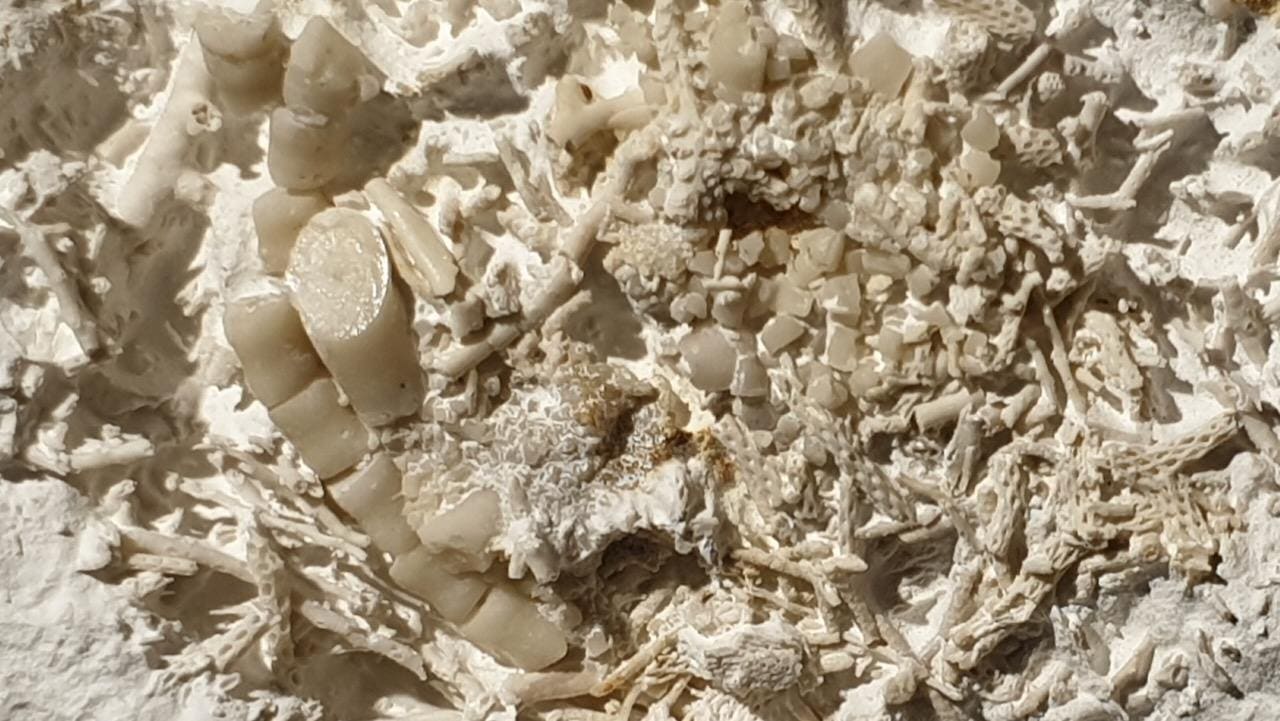A cropped closer look at the sea lily pieces in the fossil vomit found in Denmark.
Sten Lennart Jakobsen
Vomit might not seem like the most glamorous paleontological find. It’s no T. rex skull or eye-catching spiny arachnid. Ancient vomit, however, can tell scientists a lot about the time period and the animal it came from. A clump of fossilized vomit discovered in Denmark is so rare and unusual, that it’s been declared an object of exceptional natural historical value that belongs to the state.
Fossil hunter Peter Bennicke found the vomit in a piece of chalk at Stevns Klint, an area of coastal cliffs in eastern Denmark known for its fossils. Bennicke split open the chalk and discovered a collection of lily pieces. A photo of the find shows a circular lump of sea lily bits of varying sizes.
A full look at the fossil vomit found in Denmark. It dates back 66 million years.
Sten Lennart Jakobsen
Lily expert John Jagt cleaned and examined the specimen at the Geomuseum Faxe in Faxe, Denmark. Jagt noted two different species of lilies mixed together within the fossil and determined an animal likely vomited up the indigestible parts of the lilies. “In technical terms, this type of find is called ‘regurgitalite,’ and they are considered very important when reconstructing ancient ecosystems because they provide valuable information about which animals were eaten by whom,” the museum said in a statement.
What Is A Sea Lily?
Sea lilies, known as crinoids, are animals and not plants. This is what the vomited lilies might … [+] have looked like.
Charlotte Clante
The lilies found in the fossil aren’t like the flowers we see in gardens and bouquets. Ancient sea lilies are also known as crinoids. “Although they appear plant-like in many respects, they in fact are animals, complete with a digestive system and a nervous system,” the National Oceanic and Atmospheric Administration said in an explainer on crinoids.
Crinoids are common in the fossil record and can still be found in oceans today. Amateur fossil hunters can spot their distinctive round segments that sometimes look like a stack of candies or coins.
Fossil Vomit As National Treasure
The fossil vomit clump is a rare find. Denmark has a Danekræ Committee appointed by the Natural History Museum of Denmark. “The term ‘danekræ’ was introduced in 1989 to describe naturally occurring objects of exceptional natural historical value found in the earth,” the Geomuseum Faxe explained. Danekræ belongs to the state of Denmark and must be given to one of the country’s natural history museums. The committee examined the fossil vomit and found it qualified as danekræ, essentially making it a national treasure.
The clump is on display at the Geomuseum Faxe. Museum curator Jesper Milan called the vomit “truly an extraordinary find.” Milan is also a member of the Danekræ Committee. “Such a find provides important new knowledge about the relationship between predators and prey and the food chains of the Cretaceous seas,” Milan said.
Experts determined the vomit likely came from a fish that lived 66 million years ago. “Lilies are not a particularly nutritious food, as they are mainly made up of calcium plates held together by very few soft tissues,” Milan said. The fish consumed the sea lilies and then expelled the skeletal bits, completely unaware that its upchuck experience would one day be considered a valuable discovery, millions of years in the future.
